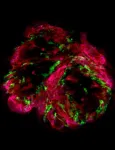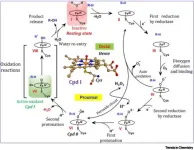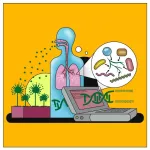(Press-News.org) BOSTON – Researchers at Dana-Farber Cancer Institute have created an AI-based tool that uses tumor gene sequencing data to predict the primary source of a patient’s cancer. The study, published in in Nature Medicine, suggests that this predictive tool, called OncoNPC, could help guide treatment of cancer and improve outcomes in difficult to diagnose cases.
The primary source of cancer is traditionally diagnosed by a standardized diagnostic work-up, including radiology and pathology assessments based on slides of cells taken from a tumor biopsy. In 3-5% of cancer cases, the original source of the tumor cannot be determined.
In these cases, patients are diagnosed with cancers of unknown primary (CUP) and have few treatment options because most treatments are approved for a specific type of cancer.
“This patient group has dismal outcomes,” says Dana-Farber researcher and senior author Alexander Gusev, PhD.
The team found that the AI model’s predictions could have value for these patients. A retrospective analysis suggested that this additional piece of diagnostic information about the primary source of the tumor could help doctors select treatments that improve survival.
“We see the OncoNPC prediction as a nudge, a way to provide a possible explanation for the cancer that helps point to appropriate treatment, including precision medicine,” says Gusev.
To build the model, the researchers trained and validated a machine learning classifier using the medical records of 36,445 patients with known primary tumors from three major cancer centers, including Dana-Farber. The records contained tumor genetic sequencing data and clinical information for each patient.
Gusev and first author Intae Moon, a graduate student at Massachusetts Institute of Technology and researcher in Gusev’s lab, chose to use a machine learning model that is interpretable, meaning that the reasoning behind the model’s prediction is more transparent than other forms of AI.
“We thought that this transparency would help clinicians trust the model,” says Moon. “It also could be clinically and biologically useful to see what genetic factors contributed to the model’s prediction, especially considering the enigmatic nature of CUP tumors.”
OncoNPC, short for Oncology NGS-based Primary cancer type Classifier, accurately predicted the origin of about 80% of tumors with known types, including metastatic tumors, using a subset of cases that had not been used as training data. The model made high confidence predictions in 65% of the tumors, meaning it assessed its prediction as having a high probability of being correct. Those predictions were 95% accurate.
They then applied OncoNPC to a separate database of 971 CUP tumors from patients seen at Dana-Farber, where a team of experts had already made a substantial effort to identify the primary source of the tumor. OncoNPC was able to predict the tumor’s origin with high confidence for 400 out of 971 (41.2%) of the cases.
To validate these predictions, the team looked at inherited germline risks of cancer among these patients and found that the risks lined up with the predictions. Further, they looked at specific cases closely to determine if the data, including pathology results, patient history, and genetic mutations supported the prediction.
“Validation is a challenge because there is no ground truth. Existing methods failed to identify the origin,” says Gusev. “But the evidence we looked at showed us that the model is on the right track.”
To determine if an OncoNPC prediction might have value to patients, the team examined the outcomes of a subset of the patients with CUP. Patients who received treatments that matched the predicted primary tumor site had longer survival compared those receiving treatments that did not match the predictions. In addition, they found that the OncoNPC predictions would enable approximately 2.2 times as many CUP patients to be matched to approved targeted medicines.
“This could open the door to more precision treatment for these patients,” says Gusev.
The tool has so far been studied using retrospective data only. To determine if it could improve outcomes for patients, it would need to be tested in a clinical trial.
Gusev and Moon plan to build on OncoNPC by expanding the data it uses for prediction to include additional diagnostic information, such as pathology results.
In addition, they would like to collaborate with a community cancer center to learn more about how OncoNPC predictions could complement existing diagnostics. Cases of CUP might be more common in smaller cancer centers because they have fewer pathologists available to devote to difficult diagnoses.
“The appeal of this approach is that tumor panels are widely available and it’s easy to run those results through the algorithm to get a prediction,” says Gusev. “It could be valuable in settings with limited resources.”
Funding: This study was funded by the National Institutes of Health, The Louis B. Mayer Foundation, The Doris Duke Charitable Foundation, The Phi Beta Psi Sorority, and the Emerson Collective.
About Dana-Farber Cancer Institute
Dana-Farber Cancer Institute is one of the world’s leading centers of cancer research and treatment. Dana-Farber’s mission is to reduce the burden of cancer through scientific inquiry, clinical care, education, community engagement, and advocacy. Dana-Farber is a federally designated Comprehensive Cancer Center and a teaching affiliate of Harvard Medical School.
We provide the latest treatments in cancer for adults through Dana-Farber Brigham Cancer Center and for children through Dana-Farber/Boston Children’s Cancer and Blood Disorders Center. Dana-Farber is the only hospital nationwide with a top 5 U.S. News & World Report Best Cancer Hospital ranking in both adult and pediatric care.
As a global leader in oncology, Dana-Farber is dedicated to a unique and equal balance between cancer research and care, translating the results of discovery into new treatments for patients locally and around the world, offering more than 1,100 clinical trials.
END
Dana-Farber AI-model predicts primary source of cancer using gene sequencing data
The tool could help guide treatment for patients in cases where traditional diagnostic methods cannot identify a primary source of the disease
2023-08-07
ELSE PRESS RELEASES FROM THIS DATE:
Game-changing potential for drug testing and cardiovascular disease treatments - Tiny Heart Model Carries Massive Implications
2023-08-07
A remarkable breakthrough, a collaborative team of researchers, led by Professor Yaakov Nahmias from The Hebrew University of Jerusalem, Technion-Israel Institute of Technology, and Tissue Dynamics Ltd., has unveiled a miniature human heart model that could potentially transform drug testing and cardiovascular research. This study, published in Nature Biomedical Engineering, introduces a self-paced multi-chambered human heart model, no larger than a grain of rice, which promises to revolutionize the way we study the heart and its functions.
Cardiovascular ...
Fanning the flames
2023-08-07
As Canadian wildfire smoke continues to impact large swaths of the United States, resulting in poor air quality and negative health outcomes for millions of Americans, more people than ever are feeling the effects of longer fire seasons and a changing climate. Now, researchers at Washington University in St. Louis have discovered that wildfires may have even bigger climate impacts than previously thought.
In a new study published Aug. 7 in Nature Geoscience, researchers led by Rajan Chakrabarty, the Harold D. Jolley Career Development Associate Professor in the ...
Effective medications for opioid use disorder rarely used
2023-08-07
Most individuals diagnosed with opioid use disorder are not on recommended medications and even fewer remain in care, according to a research letter published today in JAMA Internal Medicine by lead author Ashley Leech, PhD, assistant professor in the Department of Health Policy at Vanderbilt University Medical Center (VUMC).
In 2021, there were more than 100,000 overdose deaths in the United States, with the highest rates among those ages 25-54.
Just 22% of the 40,000 individuals with opioid use disorder studied by VUMC researchers continuously used ...
Discovery in nanomachines within living organisms - cytochromes P450 (CYP450s) unleashed as living soft robots
2023-08-07
[Jerusalem, Israel] Study reveals an important discovery in the realm of nanomachines within living systems. Prof. Sason Shaik from the Hebrew University of Jerusalem and Dr. Kshatresh Dutta Dubey from Shiv Nadar University, conducted molecular-dynamics simulations of Cytochromes P450 (CYP450s) enzymes, revealing that these enzymes exhibit unique soft-robotic properties.
Cytochromes P450 (CYP450s) are enzymes found in living organisms and play a crucial role in various biological processes, particularly in the metabolism of drugs and xenobiotics. The researchers' simulations demonstrated that CYP450s possess a fourth dimension - the ability to sense and respond to ...
Scientists crack the code of what causes diamonds to erupt
2023-08-07
An international team of scientists led by the University of Southampton has discovered that the breakup of tectonic plates is the main driving force behind the generation and eruption of diamond-rich magmas from deep inside the Earth.
Their findings could shape the future of the diamond exploration industry, informing where diamonds are most likely to be found.
Diamonds, which form under great pressures at depth, are hundreds of millions, or even billions, of years old. They are typically found in a type of volcanic rock known as kimberlite. Kimberlites are found in the oldest, thickest, ...
A fungus gets comfortable
2023-08-07
Aspergillus fumigatus strains that infect humans have a significantly altered metabolism compared to other strains in the environment. At the same time, infection with the fungus leads to an apparent change in the human lung microbiome. Researchers at the Leibniz Institute for Natural Product Research and Infection Biology (Leibniz-HKI) in Jena, Germany, came to this conclusion after using machine learning models to analyze genome data from about 250 fungal strains and lung microbiome data from 40 patients.
The fungus Aspergillus fumigatus is widely distributed in the environment, where it performs important ecological functions. ...
CEHD researchers receive funding for project on quantum teaching & learning in elementary classrooms
2023-08-07
Nancy Holincheck, Assistant Professor, Advanced Studies in Teaching and Learning, School of Education; Jessica Rosenberg, Associate Professor, Physics and Astronomy; Stephanie Dodman, Associate Professor, School of Education; and Benjamin Dreyfus, Associate Professor, Physics and Astronomy, received funding from the National Science Foundation for the project: "EAGER: Quantum is Elementary: Quantum Teaching & Learning in Elementary Classrooms."
The researchers will study learning associated with elementary teachers' engagement in professional learning and elementary students' learning related to quantum science, quantum thinking, and careers. The ...
More work needed to unlock mysteries of Asia’s bees
2023-08-07
Although the collapse of hives of European honey bees (Apis mellifera) has gained worldwide attention in recent years, there are massive gaps in knowledge of other bee species, particularly in the Asian region, which contains over half the world’s human population and where food security (in which bees play a key role) remains a major challenge.
According to a recent global analysis, only 1% of the global public data on bee distribution comes from Asia, even though 15% of the world’s bee species are thought to live there.
In a new paper, “Opportunities and challenges in Asian bee research and conservation”, published in the journal ...
Symptoms of the body and the mind are frequent fellow travelers
2023-08-07
INDIANAPOLIS – Chronic pain is often accompanied by depression and anxiety. In an invited commentary published in JAMA Network Open, Kurt Kroenke, M.D., of Regenstrief Institute and Indiana University School of Medicine, discusses the relationship between pain, the most common symptom for which individuals visit a physician, and depression and anxiety, the two most prevalent mental health conditions worldwide. He highlights the importance of not neglecting psychological symptoms in patients experiencing pain.
“One of the reasons for the bi-directional linkage between pain and depression, as well as anxiety, is the existence of a feedback ...
T. Boone Pickens Foundation donates $20 million to Wilmer Eye Institute, Johns Hopkins Medicine
2023-08-07
The T. Boone Pickens Foundation, established by the late, Texan innovative energy leader and philanthropist, is donating $20 million to the Wilmer Eye Institute, Johns Hopkins Medicine. The gift, announced in 2013, is one of the largest research donations in Wilmer’s history. It will fund vision-saving research and a professorship.
Pickens’ interest in the treatment and research of eye conditions developed in the 1980s after his father’s diagnosis of macular degeneration, a progressive condition that disrupts the central field of vision and causes ...
LAST 30 PRESS RELEASES:
Heart-brain connection: international study reveals the role of the vagus nerve in keeping the heart young
Researchers identify Rb1 as a predictive biomarker for a new therapeutic strategy in some breast cancers
Survey reveals ethical gaps slowing AI adoption in pediatric surgery
Stimulant ADHD medications work differently than thought
AI overestimates how smart people are, according to HSE economists
HSE researchers create genome-wide map of quadruplexes
Scientists boost cell "powerhouses" to burn more calories
Automatic label checking: The missing step in making reliable medical AI
Low daily alcohol intake linked to 50% heightened mouth cancer risk in India
American Meteorological Society announces Rick Spinrad as 2026 President-Elect
Biomass-based carbon capture spotlighted in newly released global climate webinar recording
Illuminating invisible nano pollutants: advanced bioimaging tracks the full journey of emerging nanoscale contaminants in living systems
How does age affect recovery from spinal cord injury?
Novel AI tool offers prognosis for patients with head and neck cancer
Fathers’ microplastic exposure tied to their children’s metabolic problems
Research validates laboratory model for studying high-grade serous ovarian cancer
SIR 2026 delivers transformative breakthroughs in minimally invasive medicine to improve patient care
Stem Cell Reports most downloaded papers of 2025 highlight the breadth and impact of stem cell research
Oxford-led study estimates NHS spends around 3% of its primary and secondary care budget on the health impacts of heat and cold in England
A researcher’s long quest leads to a smart composite breakthrough
Urban wild bees act as “microbial sensors” of city health.
New study finds where you live affects recovery after a hip fracture
Forecasting the impact of fully automated vehicle adoption on US road traffic injuries
Alcohol-related hospitalizations from 2016 to 2022
Semaglutide and hospitalizations in patients with obesity and established cardiovascular disease
Researchers ‘listen in’ to embryo-mother interactions during implantation using a culture system replicating the womb lining
How changing your diet could help save the world
How to make AI truly scalable and reliable for real-time traffic assignment?
Beyond fragmented markets: A new framework for efficient and stable ride-pooling
Can shape priors make road perception more reliable for autonomous driving?
[Press-News.org] Dana-Farber AI-model predicts primary source of cancer using gene sequencing dataThe tool could help guide treatment for patients in cases where traditional diagnostic methods cannot identify a primary source of the disease







